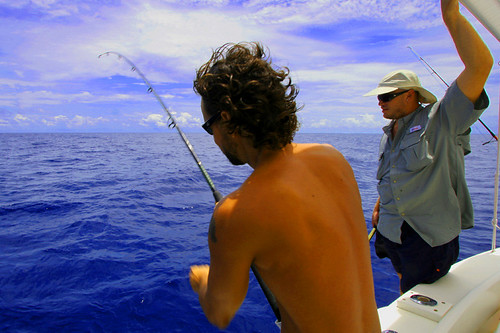 Wahoo
Wahoo, otherwise known by the Hawaiian name "
ono" are some of the fastest fish in the ocean. Much has been written about their incredible speeds with many people reporting speeds as much as 60 mph. Imagine something beneath the water getting up to 60 mph. WOW! I totally believe it too because after fishing for them since i was about 12 years old i know very well how "crazy" that can get after getting hooked. Anyone who has gone fishing and met up with them gets hooked too because they are just so awesome. Apart from their incredible speeds and fighting ability, they are a truly beautiful fish too. Streamlined like no other fish, the sleek and slender beauty of the
wahoo is complimented by the dark black colour on its top which slowly fades into a thin navy section before suddenly turning silver in the mid and lower sections of the fish. When they are in a excited situation there are dark tiger stripes along their bodies too which just add to their fighting look.
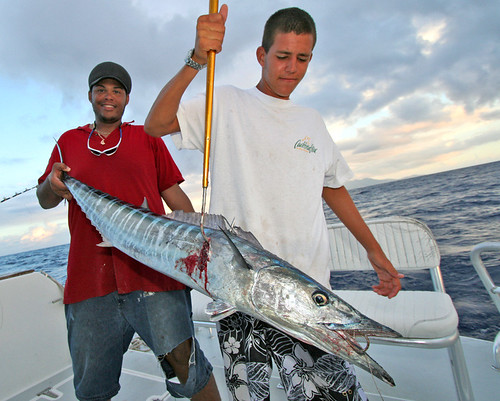
These guys are as high up on the evolutionary scale that a fish can get i think. The
mouths and teeth are something else to behold. I always laugh when people talk about "razor sharp barracuda teeth" thinking they should check out the
wahoo to see what
cuda teeth become when they evolve. The
row of perfectly shaped teeth seem to never end inside a
wahoo's mouth and believe me, these things are actually razor sharp. Great care must be taken with
wahoo and i know of several people who have been horribly damaged by active
wahoo which have just been brought aboard. You even have to be careful when putting them into a fish box dead or alive as one wrong move and another of your fish will be eviscerated or worse. There is something else about their mouths too which makes it unique and special. They are one of the the only fish or animals that i know of that has a hinged upper jaw.

When attacking something large their upper jaw hinges up even more so that they can really get their teeth around their prey. Wow, the ultimate ocean killing machine in my book is this one. But you know there is still more to this wonderful fish. They are simply delicious too which makes the fishing even more enjoyable. There are so many ways to cook them too and if not overcooked the taste is just hard to beat.

With so many other fish across the world's oceans being wiped out of course we all should be
concerned about how well the fish we eat can put up with commercial fishing. As i said in an earlier blog, Dolphin Fish (
mahi mahi) can handle commercial fishing the best, but not enough is known about
wahoo to come up with the same deduction. According to
this site,
wahoo don't face the same kind of commercial fishing pressure that tuna and other species face because they don't school in large numbers therefore making them more difficult to catch in large numbers. That site also says that not enough is known about the
life cycle of
wahoo either. Another site says that they are very similar to Dolphin Fish with respect to their ability to handle commercial fishing.
This site, says that they grow rapidly and reproduce quickly which is very important in this day and age of mass consumption. Unlike Tuna and Sword Fish "Overall,
wahoo is an excellent choice for ocean-friendly seafood." Lets hope the website is correct. The Antigua Sport Fishing Association has two tournaments a year and tomorrow is the second one. This is the first time that both of Adventure Antigua's boats will be in a tournament at the same time with some of the everyday
Adventure Antigua crew on each boat.
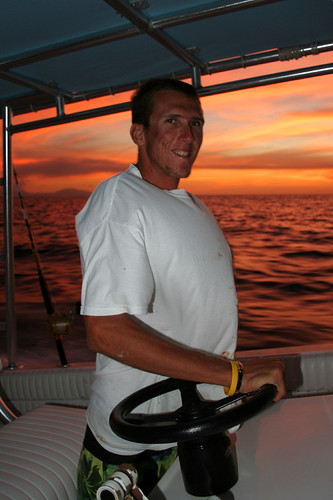
JD will captain
Xtreme with Tony

as his first mate and some other friends and family making up the crew. I will skipper the Eco boat "Arawak Odyssey" with Ross, Big John and a couple others, so it all should be some good fun. The tournament was started by my uncle Nick a few years ago and now is one of the biggest boating events of the year. This is the time of year for
wahoo and last year while i was in Brazil, Tony and JD got the largest one of the tournament out on
Xtreme. We hope to get some good photos of tomorrow's event and share them on the blog.
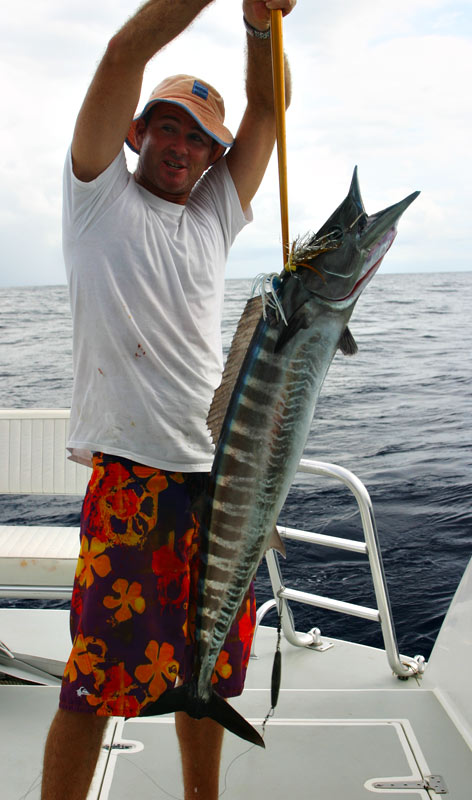
Whatever happens you know the rivalry will be in full swing over the VHF radio tomorrow. Tony and JD don't stand a chance!
hahaha Enjoy your weekend.

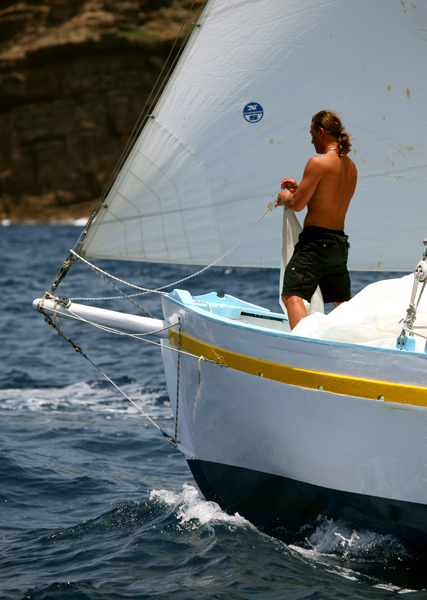 As i write this there are people looking into replanting trees in the areas where the wood is being harvested for our new boat. Our new boat which at the moment is still in the planning stages will be a traditionally built wooden sloop. I first spoke with the builders about my plans when they were here during the Antigua Classic Yacht Regatta two years ago. These guys have great passion for their trade and skills as boat builders. This brings us to another aspect to the whole green living idea. In our business we believe in hiring local people to work as guides and crew on the tours. Of course, nobody knows the island better than people with roots here, but there is more to it than just that. Using boats built by caribbean people in the caribbean to be used as tour boats owned and operated by caribbean people hopefully will become the norm here at a time when more and more of the tours are owned and operated in a different manner. Since i started my little adventure company i have taken on several small partners and i think I will continue to do so with our new venture. Shamel, who worked as a skipper on my boats will be coming into my business as a small partner in the sailing venture. He is as excited as i am about the changes we are slowly making. There have been many ideas given to me about what to do to be more "eco" and leave less of an "ecological footprint", and i appreciate them all. Our company is not all about making money, but we have to think about keeping afloat for the long voyage ahead. This isn't a get rich quick scheme and these changes are essential to maintain our island/sea lifestyles and the business as a whole. Anyway, i will blog more and more about the new boat as the process goes along. Alexis Andrews who has the lovely coffee table book "IMAGES" is coming out with a new one on Carriacou sloops which outlines the great history, culture and tradition involved in their construction as well as the amazing beauty of these lovely boats. His boat seen here is 40 feet long and quite wide.
As i write this there are people looking into replanting trees in the areas where the wood is being harvested for our new boat. Our new boat which at the moment is still in the planning stages will be a traditionally built wooden sloop. I first spoke with the builders about my plans when they were here during the Antigua Classic Yacht Regatta two years ago. These guys have great passion for their trade and skills as boat builders. This brings us to another aspect to the whole green living idea. In our business we believe in hiring local people to work as guides and crew on the tours. Of course, nobody knows the island better than people with roots here, but there is more to it than just that. Using boats built by caribbean people in the caribbean to be used as tour boats owned and operated by caribbean people hopefully will become the norm here at a time when more and more of the tours are owned and operated in a different manner. Since i started my little adventure company i have taken on several small partners and i think I will continue to do so with our new venture. Shamel, who worked as a skipper on my boats will be coming into my business as a small partner in the sailing venture. He is as excited as i am about the changes we are slowly making. There have been many ideas given to me about what to do to be more "eco" and leave less of an "ecological footprint", and i appreciate them all. Our company is not all about making money, but we have to think about keeping afloat for the long voyage ahead. This isn't a get rich quick scheme and these changes are essential to maintain our island/sea lifestyles and the business as a whole. Anyway, i will blog more and more about the new boat as the process goes along. Alexis Andrews who has the lovely coffee table book "IMAGES" is coming out with a new one on Carriacou sloops which outlines the great history, culture and tradition involved in their construction as well as the amazing beauty of these lovely boats. His boat seen here is 40 feet long and quite wide.  Apart from being very fast and beautiful, its type was designed to carry freight between the islands and therefore can carry passengers easily without much effect on performance. I just came back from Carriacou after meeting with the same boat builder who did Alexis' "Genesis".
Apart from being very fast and beautiful, its type was designed to carry freight between the islands and therefore can carry passengers easily without much effect on performance. I just came back from Carriacou after meeting with the same boat builder who did Alexis' "Genesis".  A deposit has been paid and the boat builder and his three sons start the process this week when they begin by cutting several trees in Grenada. Its a beautiful process, but some changes to tradition have been made by me. One of the changes was that we will be replanting trees which hasn't been done before by any of the boat builders there. The other thing i changed was that I got the first contract signed between a Carriacou boat builder and a purchaser. There had been a few problems with other projects there which is common anywhere in the world, but i convinced him a contract would protect him as well as me. Anyway, our new boat will be ready if all goes well fairly quickly and the blog will keep you up to date on the process of it all. Its gonna be a fun ride and i hope you join us.
A deposit has been paid and the boat builder and his three sons start the process this week when they begin by cutting several trees in Grenada. Its a beautiful process, but some changes to tradition have been made by me. One of the changes was that we will be replanting trees which hasn't been done before by any of the boat builders there. The other thing i changed was that I got the first contract signed between a Carriacou boat builder and a purchaser. There had been a few problems with other projects there which is common anywhere in the world, but i convinced him a contract would protect him as well as me. Anyway, our new boat will be ready if all goes well fairly quickly and the blog will keep you up to date on the process of it all. Its gonna be a fun ride and i hope you join us.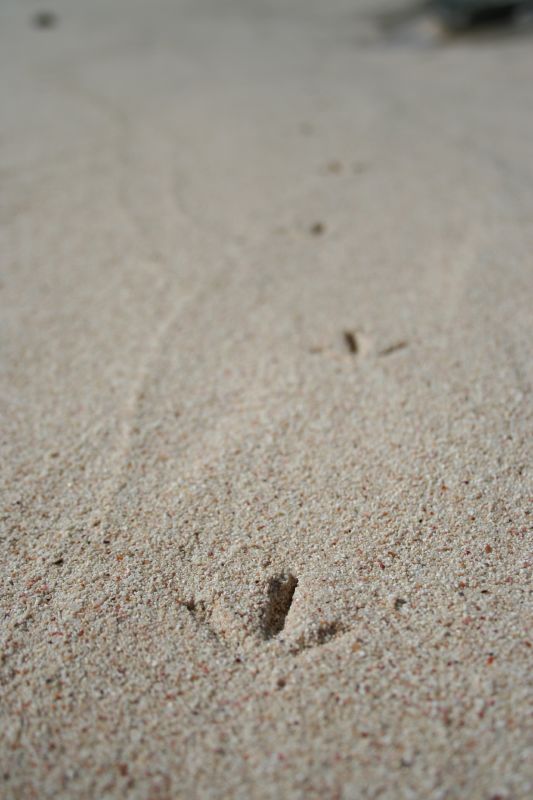


 The last boat to weigh in beat our with a 57 pound wahoo. As it got dark, Dr. Charles took the microphone to announce the awards. There were prizes for biggest fish by a woman, and second biggest fish by a woman. There were prizes for biggest fish by a youth and second biggest fish by a youth. There was a prize for biggest fish by a man, but no prize for second biggest fish by a man (much to the dismay of our crew). But the big prize was “Best in the West” which was figured by most poundage and went to Vernon Hall on Skylark. I remember my dad fishing with Vernon when I was a little kid, but for years and years Vernon hasn’t had a boat. His boat is just a year old now and the old captain got his grove back and was crowned best in the west. All of us were happy for him. We don’t know what position we came in overall, but judging from our total poundage and comparing it to Vernon’s I figure we would have been 2nd or 3rd. We did well and had fun. This is wahoo time and the 2400 lbs of fish that were caught will surely mean that when people eat fish over the next few weeks in Antigua and Barbuda it will be local instead of the imported fish from Indonesia or Thailand which seems to be so common these days. Wahoo is delicious so when you are here make sure you try some.
The last boat to weigh in beat our with a 57 pound wahoo. As it got dark, Dr. Charles took the microphone to announce the awards. There were prizes for biggest fish by a woman, and second biggest fish by a woman. There were prizes for biggest fish by a youth and second biggest fish by a youth. There was a prize for biggest fish by a man, but no prize for second biggest fish by a man (much to the dismay of our crew). But the big prize was “Best in the West” which was figured by most poundage and went to Vernon Hall on Skylark. I remember my dad fishing with Vernon when I was a little kid, but for years and years Vernon hasn’t had a boat. His boat is just a year old now and the old captain got his grove back and was crowned best in the west. All of us were happy for him. We don’t know what position we came in overall, but judging from our total poundage and comparing it to Vernon’s I figure we would have been 2nd or 3rd. We did well and had fun. This is wahoo time and the 2400 lbs of fish that were caught will surely mean that when people eat fish over the next few weeks in Antigua and Barbuda it will be local instead of the imported fish from Indonesia or Thailand which seems to be so common these days. Wahoo is delicious so when you are here make sure you try some. 
 These guys are as high up on the evolutionary scale that a fish can get i think. The
These guys are as high up on the evolutionary scale that a fish can get i think. The  When attacking something large their upper jaw hinges up even more so that they can really get their teeth around their prey. Wow, the ultimate ocean killing machine in my book is this one. But you know there is still more to this wonderful fish. They are simply delicious too which makes the fishing even more enjoyable. There are so many ways to cook them too and if not overcooked the taste is just hard to beat.
When attacking something large their upper jaw hinges up even more so that they can really get their teeth around their prey. Wow, the ultimate ocean killing machine in my book is this one. But you know there is still more to this wonderful fish. They are simply delicious too which makes the fishing even more enjoyable. There are so many ways to cook them too and if not overcooked the taste is just hard to beat.  With so many other fish across the world's oceans being wiped out of course we all should be
With so many other fish across the world's oceans being wiped out of course we all should be  JD will captain
JD will captain  as his first mate and some other friends and family making up the crew. I will skipper the Eco boat "Arawak Odyssey" with Ross, Big John and a couple others, so it all should be some good fun. The tournament was started by my uncle Nick a few years ago and now is one of the biggest boating events of the year. This is the time of year for
as his first mate and some other friends and family making up the crew. I will skipper the Eco boat "Arawak Odyssey" with Ross, Big John and a couple others, so it all should be some good fun. The tournament was started by my uncle Nick a few years ago and now is one of the biggest boating events of the year. This is the time of year for  Whatever happens you know the rivalry will be in full swing over the VHF radio tomorrow. Tony and JD don't stand a chance!
Whatever happens you know the rivalry will be in full swing over the VHF radio tomorrow. Tony and JD don't stand a chance! 
 Tony, JD, Val, Wan
Tony, JD, Val, Wan 







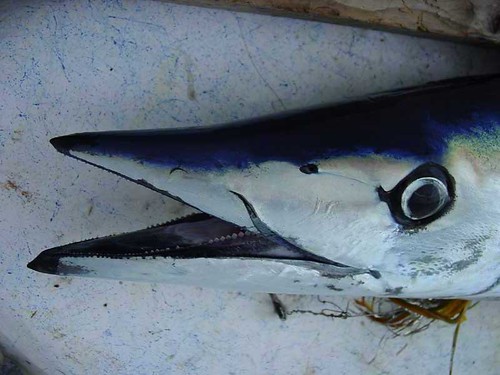
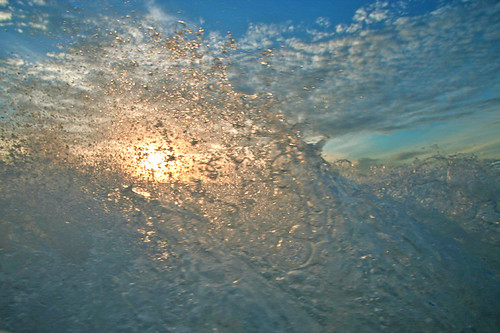 We finally got back into Jolly Harbour in the dark and set about cleaning the boat and getting rid of our fish. Cocos Hotel wanted the fish that had been sitting on ice since we had caught it. The total weight was over 100 lbs and we would have won the Dolphin (mahi mahi) prize and finished in the top 5 in the wahoo division.
We finally got back into Jolly Harbour in the dark and set about cleaning the boat and getting rid of our fish. Cocos Hotel wanted the fish that had been sitting on ice since we had caught it. The total weight was over 100 lbs and we would have won the Dolphin (mahi mahi) prize and finished in the top 5 in the wahoo division. 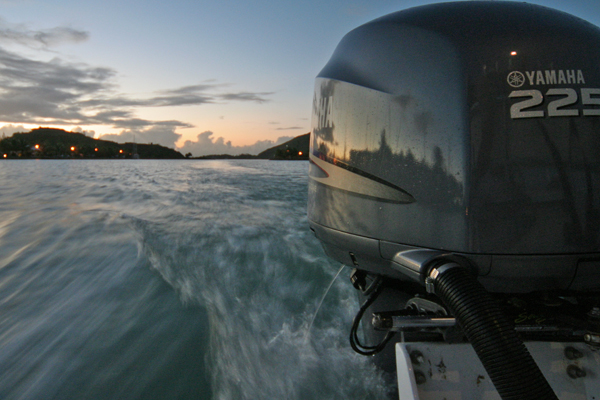

 We were running later than expected and as the sun set half way between Antigua and Nevis with our rum and cokes slipping down as was the sun, i was a little worried about how late we were.
We were running later than expected and as the sun set half way between Antigua and Nevis with our rum and cokes slipping down as was the sun, i was a little worried about how late we were.

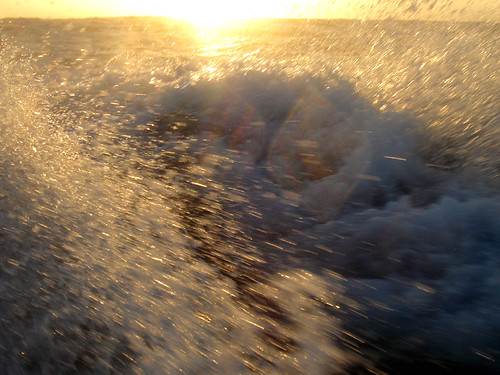 Just exactly as
Just exactly as 
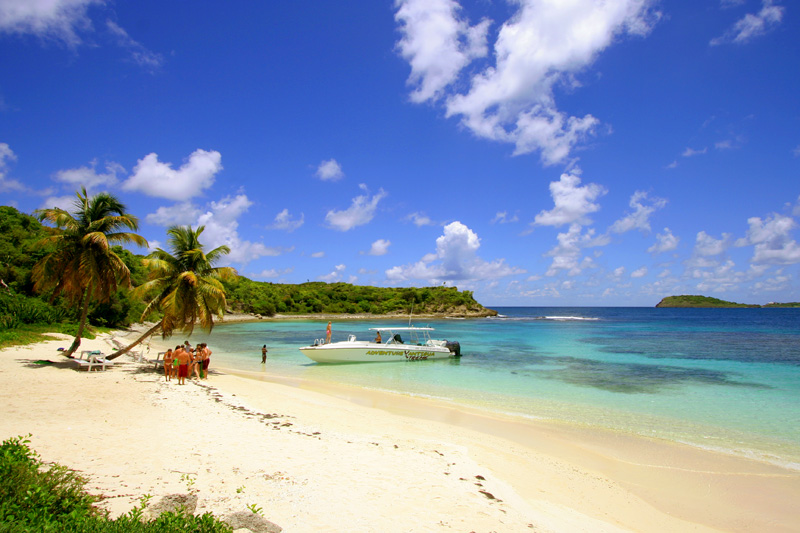
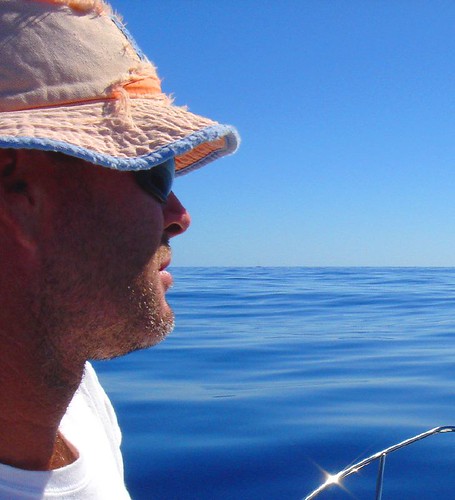 Some of the blog entries had so much interest that i was actually shocked by the response. For those of you that missed the story of Adventure Antigua you should go back and have a read.
Some of the blog entries had so much interest that i was actually shocked by the response. For those of you that missed the story of Adventure Antigua you should go back and have a read.  A new addition to our Adventure Antigua fleet is going to be built over the next 12 months and we will keep you up to date with that as i feel that it will be extremely exciting.
A new addition to our Adventure Antigua fleet is going to be built over the next 12 months and we will keep you up to date with that as i feel that it will be extremely exciting.  ITs not going to be like the yacht seen in the moonlight above but it will be nice. For now, i'd just like to thank all the regular readers. I wish you would say hi more often in the comments section this year. Dont be shy! Stay tuned for our nevis adventure coming soon.
ITs not going to be like the yacht seen in the moonlight above but it will be nice. For now, i'd just like to thank all the regular readers. I wish you would say hi more often in the comments section this year. Dont be shy! Stay tuned for our nevis adventure coming soon.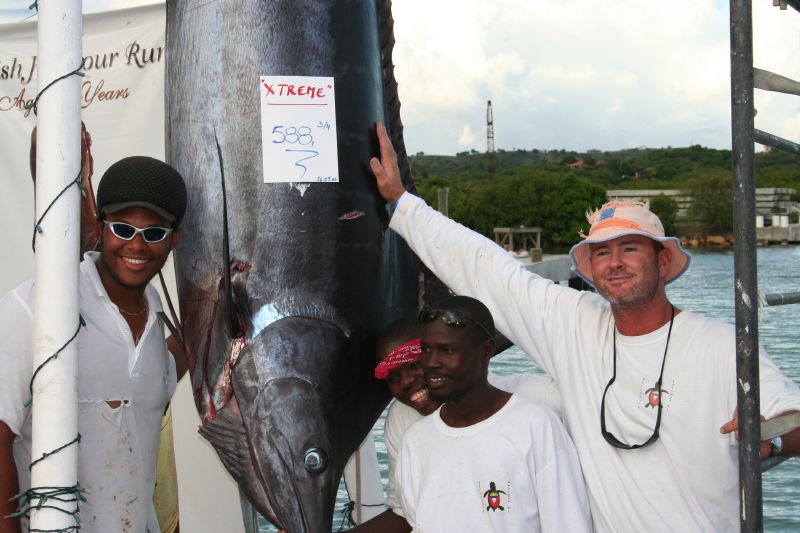
 Usually there are about 25 to 30 boats from the nearby islands, and for the past few years it has been St.
Usually there are about 25 to 30 boats from the nearby islands, and for the past few years it has been St. 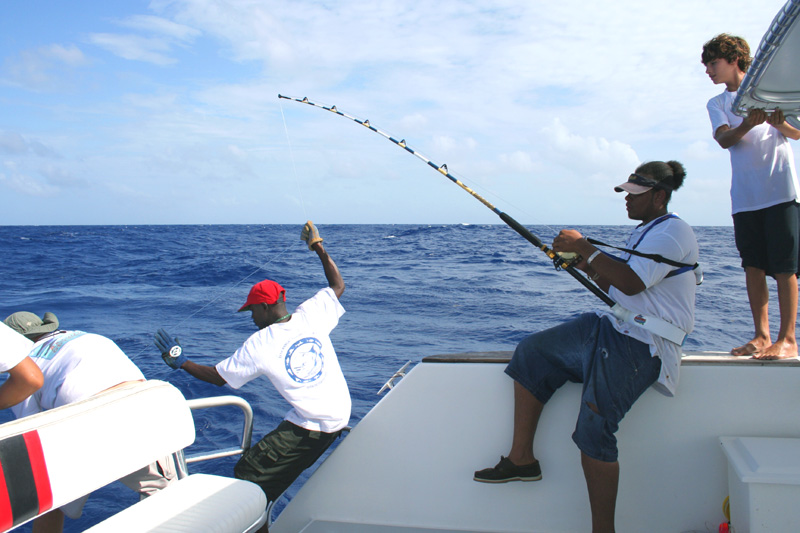
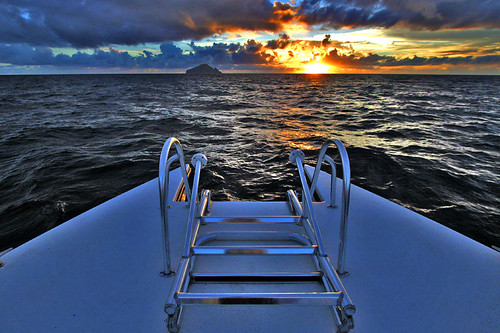
 Why am i killing fish one day and wanting fish protected another. I agree this seems a bit strange but if you understand the specifics of the fishery as well as follow carefully what i am saying then you will see that i am not against fishing. What i am, is against uncontrolled fishing here in Antigua and Barbuda. Each year we learn more and more about the species which are targeted in our waters and many decisions and practices of informed fishermen change as the information comes in. Of course there are many fishermen who don't care at all about threatened species and keep targeting them. I have done almost every type of fishing there is during some time in my life as crew and on my own. I have spear fished, netted, long line fished, fish trapped, cast from shore, bottom fished, trolled, fly fished, used lobster snares, collected conch, cockles. You name it and i have done it, but in addition to all of that i have been very interested in learning about and keeping track of how these methods of fishing affect the fishery and environment as a whole. Some of the methods above target species with very specific catches and without much by catch. Other types as in the case of net or fish traps, there are a huge range of fish including many useless species (by catch) are caught. Learning about the different methods used here and others not yet adopted here, as well as the learning about the species caught has given me my own point of view. There are many species which have been over fished in my lifetime without hope of returning in any great numbers, and there are other species in the fishery which are being caught at higher rates than they can reproduce. I personally love eating fish, and think that catching and eating fish is part of my Caribbean culture. This doesn't mean that i go out there and catch whatever i see first. Targeting species that are not threatened and that can handle the type of fishing methods we use is something that i think makes a difference. Sustainable fishing is something that the Ministry of Fisheries has no clue about and because of extreme Japanese influence here, this probably wont change anytime soon. When i go deep sea fishing with my crew, we target mahi mahi (the species most able to withstand commercial fishing), wahoo, and some types of tuna. Most other fish that we catch are released including all bill fish. We kept one large marlin in a tournament once in my life, but have released all others. Tournaments have stringent rules about what fish are allowed to be kept and each year they seem to become more eco friendly and progressive with their rules and regulations. Conservation issues are usually brought up by people within the sport fishing circle and many if not all "rules" are self imposed. This isn't something unique to Antigua either as the recreational hunting and fishing sectors all over the world have pioneered conservation fights. Not only are these conservation issues brought up and discussed by sport fishing associations, but in many cases, it is these associations that bring conservation issues before the authorities eventually getting things changed. This past weekend we went to a one day fishing tournament over in our friendly neighbor island Montserrat. We used the Arawak Odyssey boat (seen here on another fishing trip).
Why am i killing fish one day and wanting fish protected another. I agree this seems a bit strange but if you understand the specifics of the fishery as well as follow carefully what i am saying then you will see that i am not against fishing. What i am, is against uncontrolled fishing here in Antigua and Barbuda. Each year we learn more and more about the species which are targeted in our waters and many decisions and practices of informed fishermen change as the information comes in. Of course there are many fishermen who don't care at all about threatened species and keep targeting them. I have done almost every type of fishing there is during some time in my life as crew and on my own. I have spear fished, netted, long line fished, fish trapped, cast from shore, bottom fished, trolled, fly fished, used lobster snares, collected conch, cockles. You name it and i have done it, but in addition to all of that i have been very interested in learning about and keeping track of how these methods of fishing affect the fishery and environment as a whole. Some of the methods above target species with very specific catches and without much by catch. Other types as in the case of net or fish traps, there are a huge range of fish including many useless species (by catch) are caught. Learning about the different methods used here and others not yet adopted here, as well as the learning about the species caught has given me my own point of view. There are many species which have been over fished in my lifetime without hope of returning in any great numbers, and there are other species in the fishery which are being caught at higher rates than they can reproduce. I personally love eating fish, and think that catching and eating fish is part of my Caribbean culture. This doesn't mean that i go out there and catch whatever i see first. Targeting species that are not threatened and that can handle the type of fishing methods we use is something that i think makes a difference. Sustainable fishing is something that the Ministry of Fisheries has no clue about and because of extreme Japanese influence here, this probably wont change anytime soon. When i go deep sea fishing with my crew, we target mahi mahi (the species most able to withstand commercial fishing), wahoo, and some types of tuna. Most other fish that we catch are released including all bill fish. We kept one large marlin in a tournament once in my life, but have released all others. Tournaments have stringent rules about what fish are allowed to be kept and each year they seem to become more eco friendly and progressive with their rules and regulations. Conservation issues are usually brought up by people within the sport fishing circle and many if not all "rules" are self imposed. This isn't something unique to Antigua either as the recreational hunting and fishing sectors all over the world have pioneered conservation fights. Not only are these conservation issues brought up and discussed by sport fishing associations, but in many cases, it is these associations that bring conservation issues before the authorities eventually getting things changed. This past weekend we went to a one day fishing tournament over in our friendly neighbor island Montserrat. We used the Arawak Odyssey boat (seen here on another fishing trip).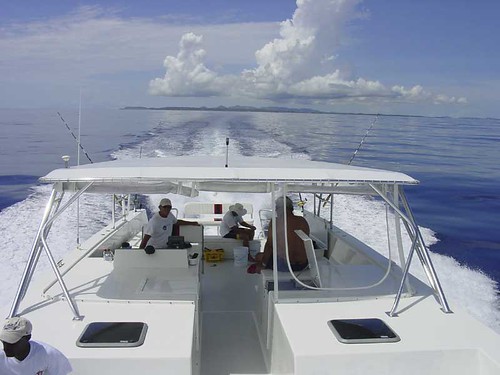 Like smugglers, we left Jolly Harbour at 3:00 am under the cover of darkness heading for Havers Shoal 38 miles away. We arrived just before lines were permitted to go over the side and there was glimmer of light showing in the East. Unfortunately, the winds were stronger than forecast and it was quite choppy. Our team consisted of
Like smugglers, we left Jolly Harbour at 3:00 am under the cover of darkness heading for Havers Shoal 38 miles away. We arrived just before lines were permitted to go over the side and there was glimmer of light showing in the East. Unfortunately, the winds were stronger than forecast and it was quite choppy. Our team consisted of 
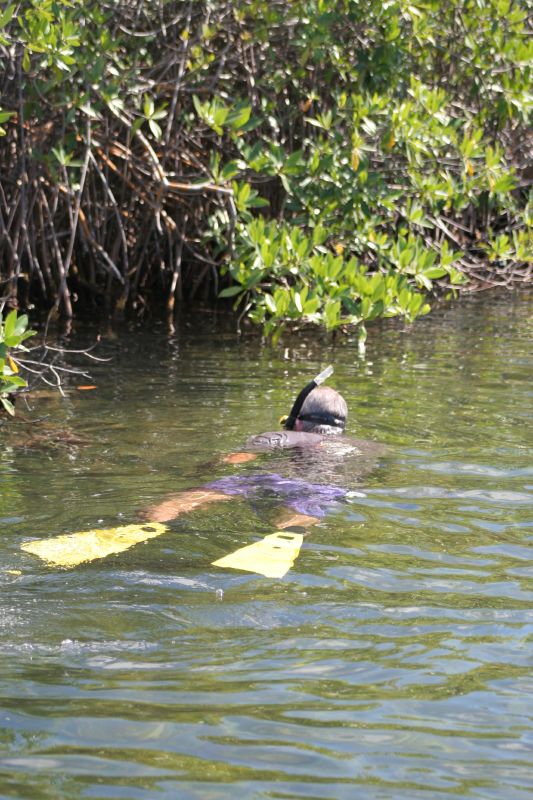
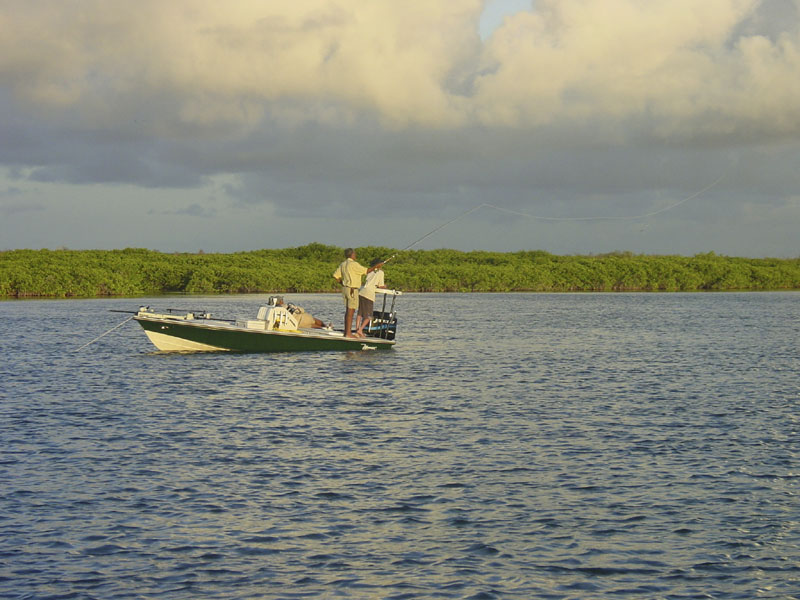 If you are interested in seeing how it all comes together then i suggest going to a bit of the coastline that has mangrove or taking an
If you are interested in seeing how it all comes together then i suggest going to a bit of the coastline that has mangrove or taking an 


 The flats alongside these mangroves below have slowly been getting mangroves covering it since the big hurricanes of the 90s.
The flats alongside these mangroves below have slowly been getting mangroves covering it since the big hurricanes of the 90s.  The habitat in many cases can grow if allowed. It isn't aways easy though as Mr. Alan Stanford discovered at Maiden Island. His development company cleared much of the mangroves there when they first started their project as you will see if you
The habitat in many cases can grow if allowed. It isn't aways easy though as Mr. Alan Stanford discovered at Maiden Island. His development company cleared much of the mangroves there when they first started their project as you will see if you